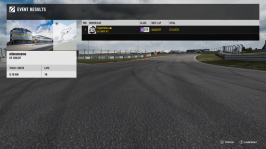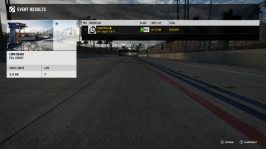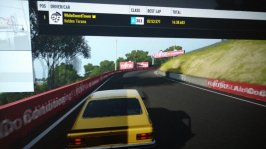Oh, wow, an IMSA double whammy? Count me in!

In the 1970s BMW, which just ten years prior was an ailing company on the verge of being bought out by their rival Daimler-Benz, was building a solid reputation on the base of the
Neue Klasse models. At the 1972 Summer Olympics, which were taking place in their hometown of Munich, they presented to the public the Turbo, a concept car clad in a futuristic body penned by Paul Bracq, equipped with a suite of technological gyzmos that would remain firmly planted in the realms of sci-fi until today (and including a radar-aided braking assist), and pushed forward by the 2-litre, turbocharged inline-4 engine of the 2002 Turbo, mounted midships. Little did the public know, but the Turbo wasn't just an idle exercise in style and fantasy: it prefigured the first (and only) German production supercar of the wedge era, the M1.
 The cockpit's the usual BMW affair - clean and driver-focused
The cockpit's the usual BMW affair - clean and driver-focused
The original design was improved upon by Giugiaro and his Italdesign company, and Lamborghini tinkered with the chassis; the 4-cylinder engine from the top-of-the-line 2002 replaced by a straight-6 displacing almost twice as much, lifted from the 3.0 CSL - the infamous "Batmobile" that in the mid-70s established the dominance of the newborn "Motorsport" division - again placed behind the cockpit, with a longitudinal orientation. The M1 was to be something that lacked from the BMW lineup at the time: a purebred racecar, built in very limited numbers to allow Munich to compete in the Group 4 and Group 5 categories of the World Sportscar Championship. However, delays in its development and changes in the rules for homologation deprived it of a chance to truly shine; the debut of Porsche's gargantuan 935 in the Group 5 division, and the decision by BMW to focus their efforts in an ambitious F1 program with Brabham put the final nail on its coffin. But there was still a category in which it was guaranteed to succeed: the Procar series.
 The brakes on the M1 are surprisingly responsive for a car of its age - allowing to delay their use quite considerably
The brakes on the M1 are surprisingly responsive for a car of its age - allowing to delay their use quite considerably
Running for two years, in 1979 and 1980, the Procar Championship was a one-make support series for the Formula 1 World Championship, originally intended by M's boss Jochen Neeerpasch to give BMW a way to develop the M1 in an actual racing environment (while selling some cars and thus bring them closer to the homologation goals). Some of the best drivers of the circus went door-to-door in the Group 4 variation of the car, entered by teams with their roots in touring car and GT racing. But by 1981, with BMW going all-in on F1, the Procar series folded, leaving Niki Lauda and Nelson Piquet as its only two champions. The cars would go on to race all over the world in different disciplines, including endurance racing and even rallying (with a car developed by Oreca and clad in the Motul colors achieving some success in the French Rally Championship, with Bernard Darniche and, later, Bernard Béguin doing the driving).
 The M88/1 inline-6 output's more than 400 hp, and one of the best soundtracks a German car's ever made
The M88/1 inline-6 output's more than 400 hp, and one of the best soundtracks a German car's ever made
For me it was love at first sight with the M1. Wedge cars were rarely adapted into racers - in their heyday they were basically evicted from the world of racing, first by the 935, and then by prototypes such as the 962 - and so the wide fender flares and tall spoiler applied to the shape make this a quite unique item. And of course there is the charm of a car that could've achieved much more, if it hadn't been so unlucky. So, is its behavior on track up to its reputation? The answer is a resounding yes. The steering is nimble and responsive, the brakes will stop you on a dime, and the motor is powerful and disciplined, if a bit peaky. No car in its division is so sure-footed... A shame it has to play catch-up to truly be competitive, then.
Still, you wouldn't expect this car to even be on the same planet as the fearsome Zakspeed Capris, or the Beta Montecarlo. Definitely a
sleeper... Although I guess having its Group 5 sister would be a reason for much celeberation.
Take a hint, T10.
Pros: there is no car from Group 4 that even comes close to it;
Cons: where is my turbocharger, T10?
Laptime (Nürburgring GP Circuit): 02:05.877

As for the Jaguar...

.
..yes?
...I've already went through its history and expressed a very positive impression of its handling
here. And I feel like there is nothing to add to what I've already said: despite my inability to find a decent pace at Long Beach, the car is suprisingly fast, especially relative to its PI rating, that'd put it in a "Early P2" category of sorts if there was one. So, not only this week's cars have had a history of success in IMSA racing, but they also punch far above their weight and aim, even in stock form, at the giants of their division.
So, again, a
sleeper - well, for as much as you call "sleeper" a Group C racing prototype, at least.
 It's not that I didn't try to go fast and use all the track...
It's not that I didn't try to go fast and use all the track...
BTW, it's nice to see someone referencing Randy Lanier and his... Uh... Out-of-the-box financing plan. The history of someone who turned into a drug kingpin to go racing (usually it's the other way around, and drug lords decide that toying around with competition machinery would be fun and/or add to their
macho image, i.e. Pablo Escobar) has impressed me so much when I first heard it, that I adopted the #56 as my racing number, in honor of mr. Lanier's successful IMSA GTP campaign. Well, now you know!
Laptime (Long Beach Full Circuit): 01:17.780





 ) been pushed to its limit on a technical track and this week I decided to record the lap.
) been pushed to its limit on a technical track and this week I decided to record the lap. 











 ) and a long standing friendly rival of mine, I put it to you as what we were racing for this week.
) and a long standing friendly rival of mine, I put it to you as what we were racing for this week. 











